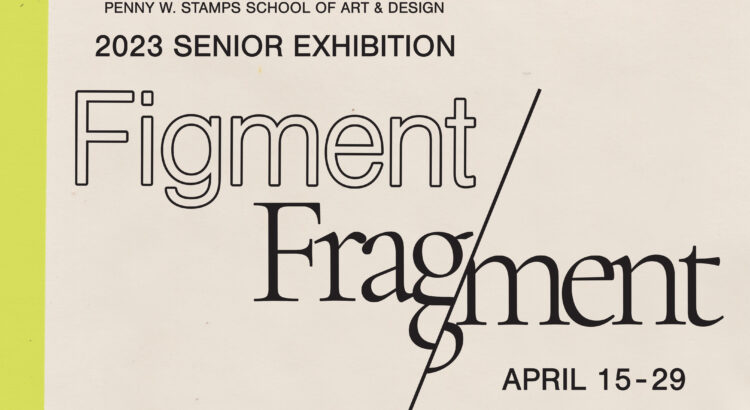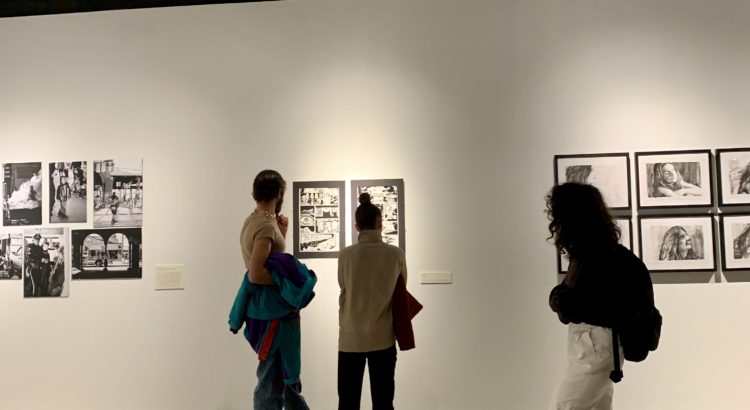
The openings for the seniors Integrative Projects (IP) at the Stamps school featured a wide variety of works from paintings to installations of around 85 student’s work. They were located at three different locations around Ann Arbor, creating the feel of an Ann Arbor art walk as people were walking between the Work Gallery on State Street to the Argus Building a few blocks down on Fourth Street. The other location was on North Campus at the Slusser Gallery.
The Work Gallery featured mostly 2-dimensional pieces. The walls were sectioned off to display each artist. On the first floor there was the work of one student where they used a 3-D printer to make these white organic forms with deep cuts and grooves in the surface. Inside the grooves sat a bright orange nondescript pill. The work invited viewers to examine more closely these manufactured sculptures not just to admire them as sculptures but, because of the placement of the pill, as containers for something. It reminds the viewer that medicine is a manufactured good and how sometimes medication and pharmaceutical companies can be an unquestioned authority when it comes to our health. A thing sometimes need to be explained more than as what it is as such but as what it is made for, how it is made, and with what goal in mind is it made. Some of these questions too can be applied to the making of the the sterile 3-D shapes that initially inspire a sense of aesthetic interest in the shape but then upon closer viewing, they inspire questions of ‘for what purpose was this sculpture made?’


Other works that were on display at the Work Gallery included a set of clutch purses inspired by the question: what do you clutch? She had made a large quantity of those clutch purses for her project, inviting the sharing of personal stories to coincide with her art-making process. Another piece was a sculpture with a physical human making the art in the gallery. What appeared to be a sculpture of a head on a pedestal also had a person sitting crouched behind the pedestal with a laptop. As he typed away searches onto his computer, information documenting those searches was transcribed on a receipt that was printed underneath the pedestal for viewers to read. Simultaneously, water was sprayed on the relief sculpture of a head causing the head to slowly disintegrate. It was a clear commentary on the visibility of our internet presence to others we are unaware of, and how the internet is shaping our identity.

The subject of internet presence is very relevant to today’s culture and other pieces in the exhibition also dealt with this issue. At the Argus Building one person created an installation of video, booklets, and USB drives. The viewer entered a partitioned area of the gallery, to a video of someone’s desktop. The video looped footage of a user opening files of different typefaces and trying out those typefaces, all of which were illegible and looked more like a seismograph readout than a written language. The booklets featured black and white images of distorted web browsers and a sign was posted above saying that it is hard to know who reads what you write on the internet and to take a USB with a custom typeface on it. Small USB’s were hung on the wall by pins and people were cautiously removing them and taking them home. The artist invites the user to take precautions against those trying to invade ones privacy. There is also a sense of appreciation for this anonymous gift. The viewer is able to not only connect with the artist through the subject matter but also by physically taking a physical part of the artwork with them.
Physically removing parts of a piece was also encouraged in another exhibit where the artist had set up tables filled with odds and ends: anything from oversized boxing gloves and a kid’s cassette player, to clay mugs and Jedi swords. A sign on the first table encouraged people to look around and if they found something they liked, the price was listed on the item, and to place the cash in the cash box. Paper bags were located under the tables for buyer’s convenience. I found the pop-up garage sale style shop in the gallery to be disorienting at first but harkening back to the removal idea from the other piece, I found that this to be another angle at tangibly connecting artist to audience.
Other pieces at the Argus Building was a large scale installation of a technicolor painted wall of an artist studio. Paintbrushes, unfinished canvases, paint cans, and other equipment, were scattered and hung on the wall and on the floor in front of the wall and all of it was colored solid with paint. The emphasis on explosions of paint and the covering up of the tools involved in painting examined the great importance of paint to the artist of the piece. Another installation was a partitioned room that was barricaded by large plant fronds. Looking through the leaves into the room, there were other plants inside, a video of a girl watering plants, pieces of roots hanging from walls. In addition, a small crane machine was placed on a pedestal right in front of the install, begging users to come try their luck at fishing for a packet of flowers the artist had made. The limited accessibility of the majority of the exhibit, except through visual perception, made the plant life seem all the more valuable. Recognizing not only the limited nature of the piece, there was also the limited use of any sort of material other than plant material in the actual piece, creating a stark contrast with the white walls of the gallery and making nature the intruder and us the outsider, as opposed to the more commonly seen dichotomy of humans as the intruder into nature.
To see these pieces and others in person, stop by the Work Gallery, Slusser Gallery, or Argus Building during open hours. The exhibition will be up from April 17- May 2.
(An aside: the catering at the galleries was amazing.)











